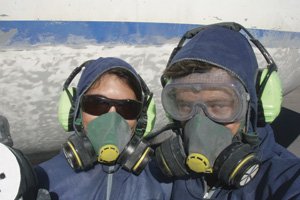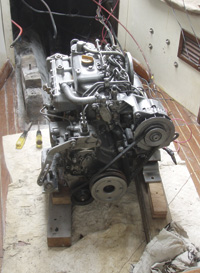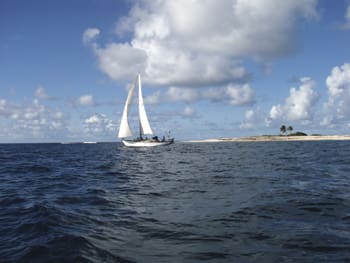In September 2006 my husband, Seth Leonard, and I were outfitting our cutter Heretic for a circumnavigation of the globe. Heretic is an old yacht, built of solid fiberglass in 1968. Her initial purchase price had been relatively low for her size, mostly due to her age and perhaps also due in part to her classic lines and configuration which left her much less room below decks than one would find in a modern yacht of the same length. Her initial cost was also a product of her condition which, we discovered, was worse than the surveyor had stated.
Almost all potential voyagers wish to strike a balance between affordability and the size of the boat they want, and this budgeting begins with the initial purchase price of a cruising yacht. Seth and I had hoped to save money by purchasing a boat cheaply and fixing her up ourselves. Over the course of our voyage, we found that this was not the bargain we had angled for. But was this just our individual experience or does this concept apply more universally?
The answer depends largely on what type of voyaging you wish to do. Taking a boat on a few weekend cruises each summer requires much less upgrading and less expense than extended bluewater voyaging. For those who wish to embark on a long voyage across oceans, purchase price is only the beginning of determining costs for a yacht. Maintenance, repairs, and upgrades can oftentimes be more expensive than the initial outlay. There is a trade off between what condition the boat is in when you buy her and how much work and money is needed to make her fit for voyaging.
Boat prices
To help potential voyagers analyze these budget concerns, I took samples of used and new monohull sailing yacht prices. A random sample of 225 used boats for sale in the Northeast of the U.S., ranging from 34 to 50 feet, indicates that the relationship between cost and length is fairly linear; for each additional foot of length, buyers can expect to pay around $14,300. In the used boat market, age and condition also drive purchase price. While condition is not easily observed, age and condition are certainly correlated: all boat construction materials are fallible and will need renovation at some point in their lives. Fiberglass will eventually require a new barrier coat to prevent blistering and osmosis which lessens the integrity of the hull; steel rusts; aluminum is at risk of galvanic corrosion; a wooden boat will need new frames and planks at some point. Finally, all boat components, from wiring to a galley foot pump, age quickly in the harsh marine environment. Of course, age does not necessarily determine condition. A recently rebuilt wooden boat or a fiberglass yacht with a new barrier coat that has been done correctly will cost more than a yacht of the same age that has not been given such attention. But in many cases, as with Heretic, the older the yacht, the worse its initial condition.
On the other hand, a sample of 49 new boats, ranging from 15 to 50 feet, indicates that in the market for new yachts price increases cubically. The increase in purchase price is roughly proportional to the increase in the boat’s volume: with every extra foot of length, the yacht will have more room above and below decks and her sail area will be larger. This non-linear trend in costs also holds true for many new components one may have to purchase over the lifetime of a boat. A Lewmar 30 alloy two-speed self-tailing winch costs $866 at West Marine; a Lewmar 46 two-speed self-tailing winch costs $1,407; and a Lewmar 50 two-speed self-tailing winch costs $2,351.
Heretic was in need of many new components. Outwardly she looked like she had been well-maintained — her brightwork shone glossy — but we quickly discovered problems and slowly learned to fix them. To make a long list brief, a badly cracked masthead meant replacing the entire rig: mast, boom, and running rigging; her electrical system was a rat’s nest of household wires, all of which needed to be replaced with marine-grade wiring and soldered or sealed connections; the propane hoses running to the galley stove were brittle with age; the head’s “holding tank” was a plastic bladder with a leak.
 |
|
Ellen and Seth Leonard in Australia outfitted to work on the hull of their Westphal 38 cutter, Heretic. |
Outfitting for voyaging
As well as repairing existing problems, we also had to outfit Heretic for offshore sailing. This included installing electronics such as a new Icom single sideband radio and Pactor modem to receive e-mails and weather files; installing safety devices such as a life raft, EPIRB, and a strobe light attached to our man-overboard pole rig; buying storm sails; installing a self-steering system in the form of an Aries wind vane; upgrading her batteries; and providing her with solar panels since some form of power generation other than the engine’s alternator is important on a voyaging yacht. Maintenance en route was almost constant, from servicing old winches and stitching torn sails to replacing our 40-year-old oil-leaking engine with a newer Yanmar. When we hauled Heretic in Australia for antifouling, we discovered osmosis in her gel coat under the waterline; we spent six weeks in Tyvek suits redoing the barrier coat.
 |
|
The Leonards purchased a used Yanmar 3HM35 to replace the 40-year-old engine in Heretic that was leaking oil and needed a complete overhaul. |
Heretic became a wonderful boat, sound, safe, and thoroughly outfitted for bluewater sailing. Almost all voyagers love their boats, and Seth and I were no exceptions. Heretic was a cozy home both at sea and in port; she sailed well on and off the wind; she brought us across long stretches of ocean without complaint; we almost never had to make a repair at sea. She braved breaking waves off South Africa’s Cape Agulhas, and because of her, Seth and I saw the green peaks of islands rise out of the swell in three oceans. But we had found that buying a boat in need of much repair can be false economy, even though we did all the work ourselves. By paying for new parts, we earned our local West Marine record sales! To sail around the world safely and comfortably, Seth and I spent three times Heretic’s initial purchase price on repairs and upgrades.
A theoretical example from the data shows that our experience with Heretic is not necessarily an aberration. For the sake of argument, say a 44-foot yacht built in 1995 will need 10 percent of her components replaced with new ones over the course of a round-the-world voyage. Ten percent of the average cost of a new 44-foot yacht — $34,130 according to the data — gives us an estimate of the cost of such upgrading. The average initial purchase price of a 1995 yacht according to the data for used yachts is $235,540. Excluding living expenses, the total cost of the voyage on this theoretical yacht will be the sum of these costs: $269,670. Compare this to a boat of the same length that is older and thus presumably in worse condition. According to the data, the initial purchase price of a 44-foot boat built in 1975 is $137,980. Assuming that the wear and tear of a global circumnavigation will require her owners to replace 40 percent of her component parts, the cost of such upgrades will be $136,520: 40 percent of the average cost of a new 44-foot yacht. The total cost of the same voyage on this yacht would then be $274,500.
Costing more overall?
Despite a lower initial price, the older yacht will cost her owners more overall. Of course, the difference in cost depends on the assumption that the older yacht will need significantly more work, but our experience with Heretic bears this out. The cost of her upgrades and repairs constituted 65 percent of the cost of a new yacht of her size according to this model.
Even with used boats, size plays a larger part in budgeting for a voyage than may first appear from the linear relationship between length and price of used yachts. To illustrate this, compare the difference in cost for a global circumnavigation aboard a 36-foot yacht and a 44-foot yacht in the same condition. Say, for example, that each requires replacement of 20 percent of their components over the course of the voyage. Twenty percent of the average cost of a new 36-foot yacht according to this data is $32,261; of a new 44-foot yacht, $68,260. A 36-foot yacht built in 1985 costs $72,359 according to this model; a 44-foot boat of the same year costs $186,760. Thus, the total cost of such a voyage aboard the 36-foot yacht would be $104,620; aboard the 44-foot yacht, $255,020. For eight more feet of length, one would pay more than twice the price. Again, the cost of component parts illustrates this large increase: a 3/8-inch turnbuckle for a stay on a 36-foot boat costs $32.99 at West Marine. A 44-foot boat would probably require a 5/8-inch turnbuckle costing $107.99.
What size and type of boat you buy depends on your budget and what type of voyaging you wish to do. As our experience with Heretic illustrates, it is sometimes difficult to determine what condition the yacht is in before you buy her. We did not know until we first took Heretic offshore and one of us tried to sleep on the port quarterberth that her coaming leaked onto it. But to some extent it is possible to know how much work awaits: a 40-year-old fiberglass yacht is most likely due for a new barrier coat. If you plan to voyage extensively and the boat does not come with self-steering, an alternative power source, and safety gear, you will have to install those. Regardless of the boat’s condition and size, maintenance will always be a cost.
A smaller boat in good condition will save you money in the long run. Nonetheless, there are reasons why some people prefer larger yachts: comfort and less motion at sea, faster hull speed and shorter offshore passages, or room for a family or to entertain friends. But whatever the size of your boat and however much work she needs, voyaging is a rewarding and challenging experience, whether it be crossing oceans or poking into coastal inlets. Although Heretic was constant work, Seth and I made time to hike up lush peaks, dive in a kelp forest off Cape Town, meet the local inhabitants, and enjoy the company of fellow voyagers along the way.
—————-
Ellen Massey Leonard circumnavigated aboard Heretic from 2006 to 2010. They sold the cutter and now are looking for a new voyaging boat from their current base in Switzerland.

